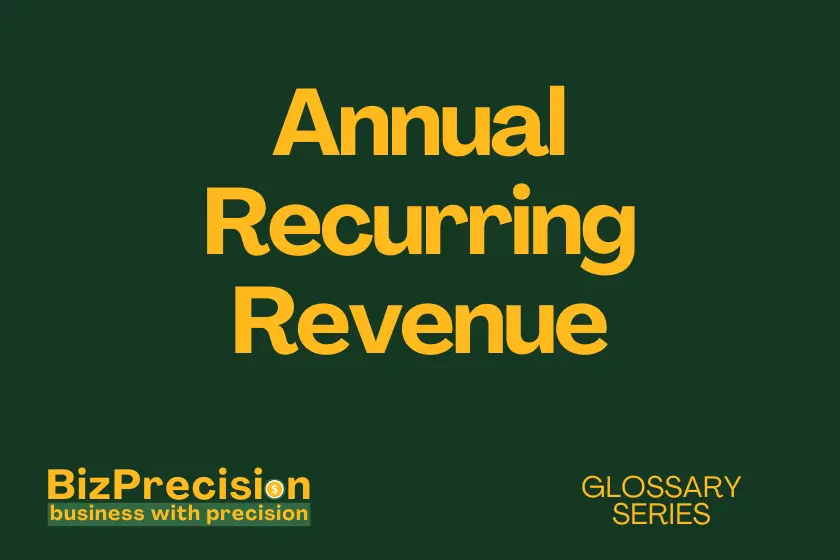What is Annual Recurring Revenue (ARR)? A Complete Guide
Annual Recurring Revenue (ARR) is the yearly value of subscription revenue a business can expect to receive from its customers.
ARR helps businesses track steady income streams from ongoing contracts. According to OpenView’s 2023 SaaS Benchmarks Report, companies with strong ARR growth of over 100% secure valuations 2.5 times higher than their competitors. This metric shapes how investors and leaders view business health.
Understanding Annual Recurring Revenue
How ARR is Calculated
The basic ARR formula is simple: multiply your total monthly recurring revenue by 12. Let’s break this down with real numbers. A customer paying $1,000 monthly equals $12,000 in ARR.
Two key rules make ARR calculations accurate:
- One-time fees don’t count: Setup costs and training fees stay out of ARR math. These charges bring in money once but don’t create lasting value. A software company charging $5,000 for setup keeps this separate from their ARR total.
- Only include yearly contracts: Short-term deals under 12 months belong in different metrics. Many businesses track these as Monthly Recurring Revenue (MRR) instead. This helps paint a clear picture of long-term income.
Differences Between ARR and MRR
ARR and MRR serve different purposes in business planning. ARR focuses on yearly patterns while MRR tracks monthly changes. Here’s why this matters:
- Scale perspective: ARR suits enterprise deals with yearly contracts. MRR works better for smaller, month-to-month subscriptions. A company selling $50 monthly plans to consumers would focus on MRR.
- Growth tracking: MRR shows quick shifts in customer behavior. ARR reveals longer trends that shape company strategy. Changes in ARR often signal deeper business health issues.
Components of ARR
Four key parts make up your total ARR number:
- New ARR: Revenue from first-time customers starting yearly contracts. A startup landing its first $100,000 yearly client adds this full amount to new ARR.
- Expansion ARR: Extra revenue when current customers spend more. This happens through upgrades or adding users. A client increasing their yearly spend from $10,000 to $15,000 adds $5,000 to expansion ARR.
- Contraction ARR: Lost revenue when customers reduce spending but stay. If a client drops from a $20,000 to a $15,000 yearly plan, that’s $5,000 in contraction.
- Churned ARR: Money lost when customers leave entirely. A $50,000 yearly customer ending their contract equals $50,000 in churn.
Key ARR Benchmarks by Industry
Different industries show varied ARR patterns. Recent data from SaaS Capital reveals these benchmarks:
- Enterprise Software: Top performers see 100%+ yearly ARR growth
- Mid-market SaaS: Healthy companies grow ARR by 40-60% yearly
- Small Business Tools: Expected ARR growth ranges from 20-40%
These numbers help companies set realistic goals. A mid-market company aiming for 50% ARR growth knows they’re on track with industry standards.
Benefits and Applications of ARR
Revenue Forecasting and Planning
ARR makes future planning more accurate. It gives leaders clear data to make choices about:
- Growth investments: Stable ARR supports smart spending choices. A company with $5M in ARR growing 40% yearly can plan hiring with confidence.
- Resource allocation: Known future income helps divide resources well. Teams can better match staff levels to customer needs when they know their ARR trends.
- Budget setting: ARR patterns guide spending plans. Companies often set budgets at 70-80% of their ARR to maintain healthy margins.
Investor Relations and Valuations
ARR strongly influences company worth. According to SaaS Capital’s 2023 report, each dollar of ARR typically creates $8-12 in company value. This matters for:
- Funding rounds: Higher ARR often means better investment terms. Investors pay special attention to ARR growth rates above 40%.
- Company sales: ARR multiples help set fair prices. A company with $10M ARR might sell for $80-120M based on current markets.
- Board reporting: Regular ARR updates keep stakeholders informed. Monthly or quarterly ARR tracking shows business health clearly.
Performance Tracking
ARR helps measure business success through:
- Customer health scores: Rising ARR per customer shows strong relationships. Tracking this number helps spot growing accounts.
- Sales team metrics: ARR growth per rep shows sales success. Top performers often bring in new ARR equal to 3-5 times their cost.
- Product adoption: Expansion ARR signals customers find more value. This often leads to higher retention rates.
Growth Rate Analysis
Understanding ARR growth reveals business strength:
- Year-over-year comparisons: Steady growth shows good health. Most successful SaaS companies maintain 40%+ yearly ARR growth.
- Cohort analysis: Tracking ARR by customer groups shows trends. Newer customers often show different growth patterns than older ones.
- Market penetration: ARR growth rates suggest market position. Slowing growth might mean time to explore new markets.
Customer Success Metrics
ARR links directly to customer happiness through:
- Net retention rates: This shows ARR changes in existing customers. Rates above 100% mean customers spend more over time.
- Upgrade patterns: Rising ARR from current customers suggests satisfaction. Happy customers often increase their spending by 15-30% yearly.
- Churn prevention: Watching ARR changes helps spot at-risk accounts. Quick action can save 40-60% of customers showing spending drops.
ARR Best Practices and Strategies
Tracking and Reporting Methods
Smart ARR tracking needs clear systems:
- Regular updates: Monthly ARR reviews catch trends early. This helps teams respond quickly to changes.
- Clear metrics: Standard ARR calculations keep reporting honest. Everyone should use the same rules to count revenue.
- Automated tools: Software helps track ARR accurately. Modern systems can split revenue types automatically.
Improving ARR Performance
Companies can boost ARR through focused work:
- Customer success programs: Happy customers renew contracts more. Research shows that companies with strong success teams see 15% higher renewal rates.
- Expansion strategies: Planned upgrade paths increase spending. Offering clear growth options helps customers spend more naturally.
- Value demonstration: Regular business reviews show ROI. Customers who see clear value renew at higher rates.
Common ARR Calculation Mistakes
Avoid these frequent errors:
- Including one-time fees: Setup costs don’t count as ARR. Keeping these separate gives clearer pictures of recurring income.
- Missing contract changes: Price adjustments affect ARR immediately. Update your numbers as soon as contracts change.
- Forgetting to normalize: All contracts should convert to yearly values. This keeps ARR consistent across different billing periods.
ARR in Different Business Models
ARR works differently across companies:
- Enterprise SaaS: Long contracts mean stable ARR. These companies often see lower churn but slower growth.
- SMB focus: Shorter deals need closer ARR tracking. These businesses might see faster growth but more customer turnover.
- Hybrid models: Mixed income needs careful ARR separation. Keep subscription revenue distinct from other income.
Future-Proofing Your ARR Strategy
Plan ahead for ARR success:
- Market changes: Watch industry trends for ARR impacts. New technology or competition might affect pricing power.
- Customer needs: Adapt offerings to maintain ARR. Regular customer feedback helps shape future products.
- Economic shifts: Build flexible ARR models. Different payment options help maintain income during tough times.
Conclusion
Annual Recurring Revenue (ARR) remains central to subscription business success. Focus on clean tracking, customer happiness, and smart growth strategies. Start by reviewing your current ARR calculation methods. Then build a plan for steady growth.
Take action now: Check your ARR tracking against these guidelines. Set clear growth targets based on your industry benchmarks. Create a system for monthly ARR reviews with your team.







